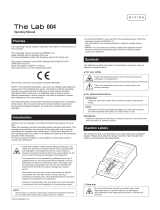
Table of Contents
5
1 Introduction 9
The cobas h 232 meter................................................................................................................... 9
Test principle ..................................................................................................................................... 10
Contents of the Pack ...................................................................................................................... 10
Important safety instructions and additional information......................................................... 11
Safety information............................................................................................................................ 12
Disposal of the system ................................................................................................................... 12
General care....................................................................................................................................... 13
Laser scanner .................................................................................................................................... 13
Electrical safety ................................................................................................................................. 13
Electromagnetic interference ...................................................................................................... 13
Touchscreen....................................................................................................................................... 13
2 The cobas h 232 POC System 14
Overview of the meter and its accessories..................................................................................... 14
Meter ................................................................................................................................................... 14
Test strip.............................................................................................................................................. 17
Handheld Base Unit ........................................................................................................................ 18
3 Overview of the Buttons and Icons used on Screen 19
4 Putting the Meter into Operation 21
Power supply...................................................................................................................................... 22
Inserting the handheld battery pack......................................................................................... 23
Powering the meter on and off................................................................................................... 25
5 Meter Setup 27
Settings summary............................................................................................................................. 28
Basics setup ............................................................................................................................................... 33
Contrast ............................................................................................................................................... 33
Language ............................................................................................................................................ 35
Setting the date................................................................................................................................. 37
Setting the time................................................................................................................................. 39
Setting the display options for date and time ....................................................................... 41
Sound.................................................................................................................................................... 43
Auto off ................................................................................................................................................ 46
Data Handling setup ............................................................................................................................... 48
Connection ........................................................................................................................................ 48
Computer............................................................................................................................................. 49
Printer ................................................................................................................................................... 50
Result memory .................................................................................................................................. 52
ID Setup setting ........................................................................................................................................ 55
Administrator ID ............................................................................................................................... 56
Operator ID......................................................................................................................................... 62
Patient ID............................................................................................................................................. 65
Lockout setup............................................................................................................................................ 67
Operator lockout............................................................................................................................... 68
Quality control (QC) settings ....................................................................................................... 71
Quality control (QC) lockout ........................................................................................................ 73
Instrument quality control (IQC) lockout................................................................................. 74
QC result format ............................................................................................................................... 75
Custom Range Troponin T............................................................................................................ 76
Reset test parameters..................................................................................................................... 78
Cleaning lockout............................................................................................................................... 79
STAT test configuration ........................................................................................................
......... 80
Optional Screens setup
.......................................................................................................................... 82























